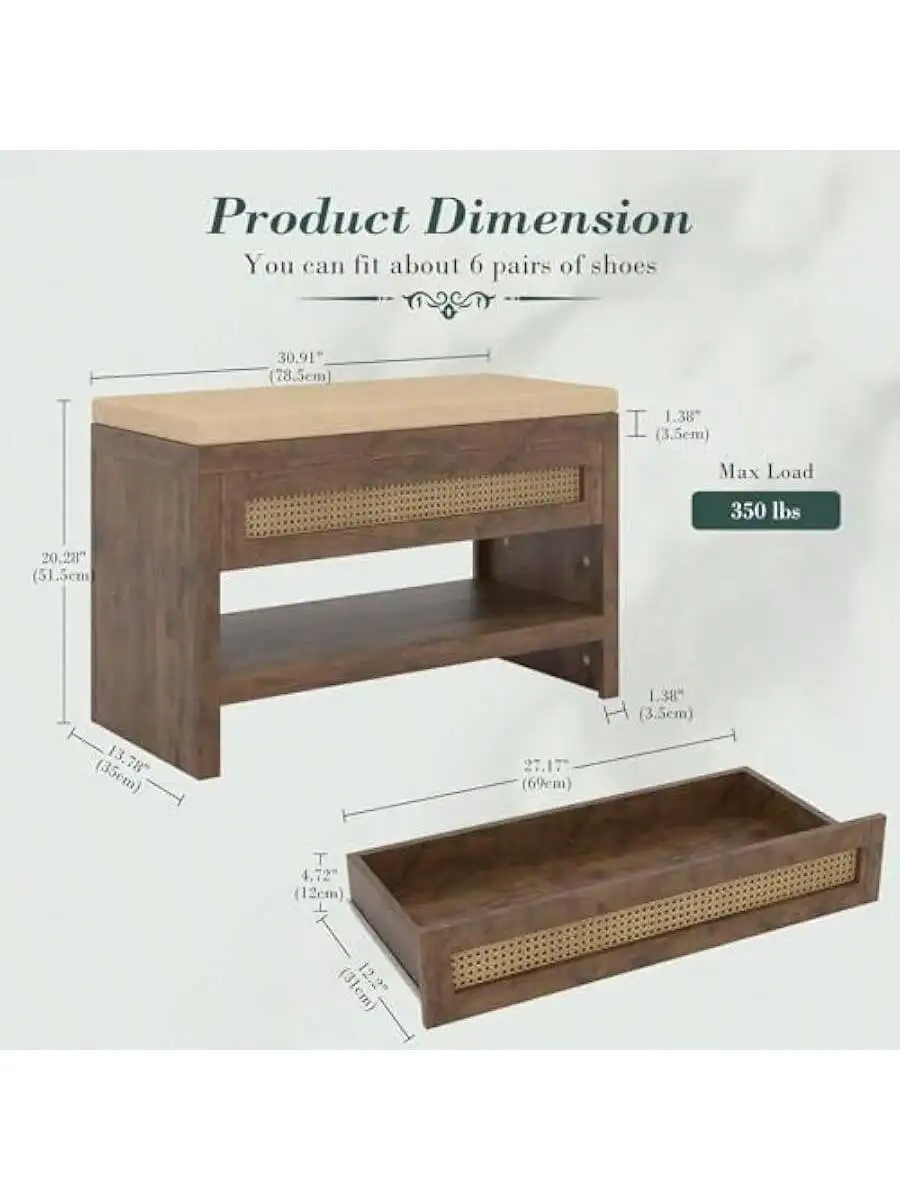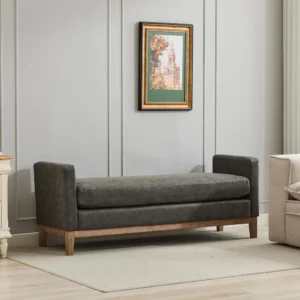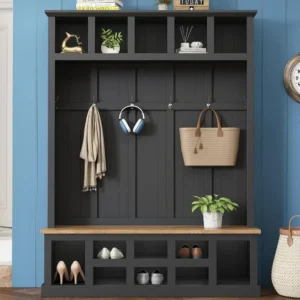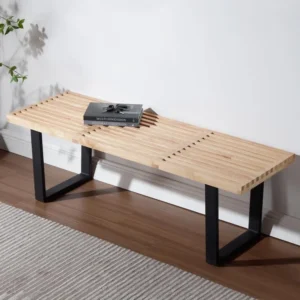Understanding the Dual Purpose of Entryway Benches
The entryway bench serves as both a functional piece of furniture and a welcoming element in your home’s entrance. Unlike other furniture that might prioritize one aspect over another, the ideal entryway bench must strike a delicate balance between comfort and utility to truly serve its purpose.
Your entryway creates the first impression of your home while simultaneously functioning as a transition space where practical activities occur daily—removing shoes, setting down bags, or briefly sitting while preparing to leave. This dual role demands thoughtful consideration of both comfort features and functional elements.
The most effective entryway benches succeed by:
- Providing comfortable seating for putting on or removing footwear
- Offering practical storage solutions for everyday items
- Complementing your entryway’s aesthetic to create a welcoming atmosphere
- Withstanding the high traffic and varied demands of an entrance area
Research has consistently shown that well-designed entryways significantly impact how people perceive a home’s overall appeal and functionality. A thoughtfully balanced bench serves as the cornerstone of this impression.
The key to selecting the perfect entryway bench lies in understanding how your specific entryway functions within your lifestyle and transforming your entryway with space-saving benches that accommodate both practical needs and comfort requirements.
Essential Comfort Elements: Creating an Inviting Entryway Seating Experience
Ergonomic Design Considerations
A truly comfortable entryway bench begins with proper ergonomics—the science of designing furniture that works with the human body rather than against it. The perfect entryway bench height typically ranges between 17-19 inches (43-48 cm), allowing most adults to sit with feet flat on the floor while maintaining proper posture. Seat depth is equally important, with 15-18 inches (38-46 cm) providing enough support without forcing users to perch uncomfortably on the edge.
Material Selection for Comfort
The materials you choose dramatically affect the comfort level of your entryway bench:
- Performance fabrics offer a soft touch while resisting stains and wear—ideal for busy entryways
- Leather provides a luxurious feel that often improves with age while remaining easy to wipe clean
- Velvet delivers unmatched softness and visual warmth, though requires more maintenance
Cushioning Considerations
The cushioning in your entryway bench cushion plays a crucial role in both immediate comfort and long-term satisfaction:
- Memory foam contours to body shape, offering personalized support for each user
- High-density foam provides firmer support that maintains its shape over years of use
- Fiber fill creates a softer, more casual sitting experience with regular fluffing needed
Psychological Comfort Factors
Beyond physical comfort, your entryway bench should evoke a sense of welcome. Rounded edges, warm materials, and thoughtful details create an inviting impression that makes coming home a pleasure rather than just a practical necessity.
The right combination of these comfort elements ensures your entryway bench serves as a comfortable transition point—whether you’re sitting to lace up shoes before heading out or taking a moment to unwind after returning home.
Utility Features That Make Entryway Benches Highly Functional
A truly useful entryway bench must address the practical challenges of this high-traffic area through thoughtful design and functionality. Beyond comfortable seating, consider these essential utility elements that transform an ordinary bench into an organizational powerhouse.
Integrated Storage Solutions
Modern entryway bench storage comes in various configurations to address different organizational needs:
- Shelf storage (open underneath) provides quick access to frequently used items and accommodates larger footwear
- Drawer storage conceals clutter while keeping smaller items organized and dust-free
- Lift-top storage maximizes capacity by utilizing the entire bench footprint for seasonal items
- Cubbies create designated spaces for each family member’s belongings, reducing morning chaos
Storage capacity varies significantly between bench styles, from compact designs offering 2-3 cubic feet to expansive units providing 8+ cubic feet of organizational space.
Material Durability Considerations
Entryway benches face unique challenges including:
– Frequent moisture exposure from wet shoes and outerwear
– Abrasion from gritty outdoor elements
– Temperature fluctuations near exterior doors
– Daily use by multiple household members
Top-performing materials for entryway conditions include:
- Solid hardwoods (oak, maple, walnut) with protective finishes
- Powder-coated metals resistant to scratching and moisture damage
- High-grade engineered woods with quality laminates for moisture resistance
- Performance fabrics rated for 30,000+ double rubs on the Wyzenbeek scale
Structural Integrity
Most quality entryway benches should support 250-400 pounds (113-181 kg), accommodating multiple seated adults or heavy storage items. Look for reinforced joinery methods like dovetail joints, mortise and tenon connections, or metal reinforcement brackets that maintain stability through years of use.
Maintenance Requirements
Practical entryway benches should feature:
– Easily wiped surfaces for quick cleanup of outdoor debris
– Removable cushion covers for washing
– Accessible storage areas that don’t collect dust in hard-to-reach corners
– Scratch-resistant finishes that maintain appearance despite daily use
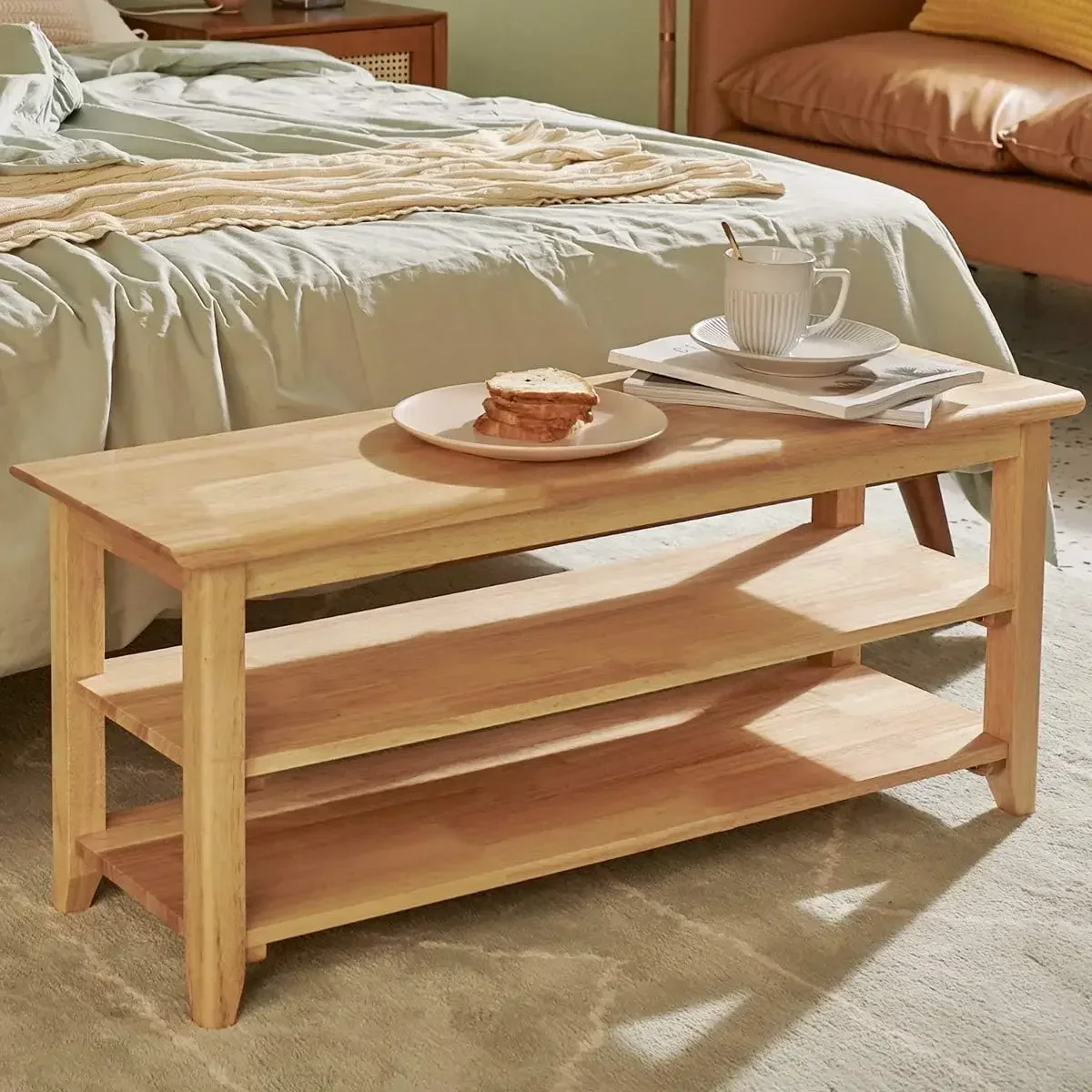
Assessing Your Specific Needs: Personalizing Your Comfort-Utility Balance
Finding your ideal comfort-utility balance begins with an honest assessment of your household’s unique requirements and entryway conditions. Consider these key factors when determining which bench features deserve priority in your space.
Lifestyle Analysis Questions
Ask yourself these questions to clarify your specific needs:
- How many people regularly use your entryway?
- What seasonal items need storage near your entrance?
- How long do people typically sit on the bench (quick shoe changes or longer waits)?
- What items consistently create clutter in your current entryway setup?
- Do you need specialized storage for pet supplies, children’s items, or sports equipment?
Space Assessment Methodology
Before selecting a bench, carefully measure your available space:
– Allow minimum clearance of 36 inches (91 cm) for walkways around the bench
– Consider door swing patterns to avoid obstruction
– Measure wall height if considering a bench with vertical components
– Identify nearby outlets that might affect placement
For those with spatial constraints, best small benches for entryways offer specialized solutions that maximize functionality without overwhelming limited space.
Traffic Pattern Considerations
High-traffic households with multiple family members might prioritize:
– Durable materials over plush comfort
– Maximum storage capacity for varied belongings
– Designated storage zones for different household members
Meanwhile, lower-traffic homes might favor:
– Enhanced comfort features like premium cushioning
– Aesthetic details that complement interior design
– Specialized storage for specific items rather than maximum capacity
Your ideal balance point exists at the intersection of your practical requirements, available space, and personal preferences—there’s no one-size-fits-all solution for the perfect entryway bench.
Material Selection: Impact on Both Comfort and Functionality
The materials you select for your entryway bench significantly influence both comfort and utility aspects, often requiring thoughtful compromise to achieve the right balance for your home.
Wood Options
Wood entryway benches remain perennially popular due to their natural warmth and durability. Different wood types offer varying comfort-utility profiles:
- Oak (1360 on Janka hardness scale): Offers excellent durability with distinctive grain patterns that hide minor scratches, though requires cushioning for comfortable seating
- Maple (1450 Janka): Provides exceptional hardness for high-traffic areas with a smoother, more uniform appearance
- Walnut (1010 Janka): Delivers natural beauty with slightly more give for comfort, though at a higher price point
- Rubberwood (900 Janka): Presents an eco-friendly option with moderate durability and a more affordable price
Metal Components
Metal elements contribute structural strength while influencing both aesthetic and comfort:
- Steel frames provide maximum weight capacity with minimal visual bulk
- Cast iron offers vintage appeal with exceptional durability
- Aluminum reduces overall weight for easier repositioning
- Bronze or brass accents add warmth while maintaining durability
Most metal components benefit from cushioned seating to enhance comfort without sacrificing their structural advantages.
Upholstery Materials
Upholstery directly impacts comfort while presenting unique maintenance challenges in entryway conditions:
- Performance fabrics (typically 30,000+ double rubs) resist stains and moisture while providing comfort
- Genuine leather develops character with age while remaining relatively easy to clean
- Vinyl alternatives offer leather-like appearance with enhanced moisture resistance
- Outdoor-rated fabrics provide maximum durability for exposed entryways
Hybrid Material Approaches
Many successful entryway benches combine materials strategically:
- Wooden frames with upholstered seats balance structural integrity with sitting comfort
- Metal bases with wooden tops blend industrial durability with natural warmth
- Woven elements (rattan, seagrass) introduce texture while providing flexible support
When selecting materials, consider your specific entryway conditions including moisture exposure, temperature fluctuations, and direct sunlight—all of which can significantly impact both comfort and longevity of different material options.
Smart Design Features That Blend Comfort and Utility Seamlessly
The most successful entryway benches incorporate thoughtful design elements that serve both comfort and utility purposes simultaneously rather than treating them as competing priorities.
Ergonomic Storage Integration
Forward-thinking designs recognize that storage features themselves can enhance comfort when properly executed:
- Angled shoe shelves that improve accessibility while creating ergonomic backrest angles
- Soft-close drawers that prevent pinched fingers while protecting stored items
- Cushioned lift-tops with hydraulic supports that eliminate heavy lifting
- Storage compartments positioned to double as comfortable armrests
Adaptive Modular Features
Flexibility allows your entryway bench to adapt as your needs change over time:
- Adjustable shelf heights accommodate seasonal footwear changes
- Removable dividers transform open storage into customized compartments
- Modular components that can be rearranged as entryway traffic patterns change
- Convertible designs that expand or contract based on seasonal storage needs
Space-saving entryway ideas incorporate these adaptive features to maximize functionality without sacrificing comfort in even the most limited entry spaces.
Thoughtful Comfort Enhancements
Small design details often deliver significant comfort improvements with minimal impact on utility:
- Contoured seat surfaces that distribute weight more evenly
- Waterfall edge designs that reduce pressure on the back of thighs
- Strategically placed padding that doesn’t interfere with storage access
- Breathable materials in high-contact areas to enhance sitting comfort
Visual Harmony Considerations
Aesthetically balanced designs create psychological comfort while maintaining functionality:
- Visual lightness through tapered legs or floating components
- Proportional storage elements that don’t overwhelm the seating function
- Complementary textures that add visual interest while serving practical purposes
- Cohesive design language that integrates your bench with surrounding entryway elements

Popular Entryway Bench Styles and Their Comfort-Utility Profiles
Different entryway bench styles prioritize comfort and utility aspects in varying proportions. Understanding these inherent tendencies helps you select a style that naturally aligns with your priorities.
Classic Storage Bench
Comfort Score: 7/10
Utility Score: 9/10
The traditional storage bench features a hinged seat revealing storage underneath. This design maximizes storage capacity but may compromise seating comfort with a firmer surface. Best suited for busy family entryways where organization takes priority, though cushion additions can enhance comfort significantly.
Upholstered Ottoman Bench
Comfort Score: 9/10
Utility Score: 5/10
Focusing primarily on seating comfort, upholstered ottoman benches feature generous padding and soft materials. While offering limited storage (typically none or a small lift-top compartment), they excel in creating a welcoming, comfortable first impression. Ideal for formal entryways where aesthetic appeal and occasional comfortable seating outweigh heavy storage requirements.
Minimalist Bench
Comfort Score: 6/10
Utility Score: 4/10
Sleek modern entryway benches emphasize clean lines and visual lightness, often featuring simple wooden slats or metal frames with minimal cushioning. While offering limited dedicated storage, their open designs accommodate baskets underneath. Perfect for contemporary homes valuing aesthetic clarity and visual spaciousness over maximum functionality.
Hall Tree Combination
Comfort Score: 7/10
Utility Score: 10/10
Comprehensive hall trees and coat rack benches represent the ultimate utility-focused option, combining seating with storage below and vertical organization above (hooks, shelves, and sometimes mirrors). These all-in-one solutions maximize functionality in limited spaces but require sufficient ceiling height and may feel visually substantial in smaller entries.
Farmhouse Bench
Comfort Score: 5/10
Utility Score: 7/10
Characterized by solid wood construction with rustic detailing, farmhouse benches offer durability and moderate storage (typically open shelving). While the wooden seating requires cushions for comfort, these benches deliver excellent longevity and complement traditional home styles with their unpretentious, practical design language.
Mid-Century Modern Bench
Comfort Score: 8/10
Utility Score: 6/10
Featuring tapered legs, clean lines, and often incorporating upholstered elements, mid-century modern benches balance comfort and moderate storage capability. Their distinctive aesthetic works well in contemporary and eclectic entryways where style carries equal importance to function.
Each style offers an inherent comfort-utility balance, but can be modified with accessories or custom elements to shift that balance toward your specific needs.
Practical Solutions for Common Entryway Challenges
Even the most challenging entryway conditions can be accommodated with strategic bench selections that address specific spatial and functional constraints.
Space-Challenged Entryways
When every inch counts, consider these approaches:
- Narrow-profile benches under 36 inches (91 cm) wide that still incorporate storage
- Corner designs that utilize often-wasted angular spaces
- Wall-mounted floating benches that create storage without consuming floor space
- Nested designs where seating partially tucks under storage components when not in use
Organizing a small entryway with a bench requires thoughtful consideration of vertical space and multi-functional components that maximize utility without overwhelming limited square footage.
High-Traffic Family Entryways
Busy households with multiple family members benefit from:
- Divided storage sections creating designated spaces for each family member
- Easily cleanable materials that withstand muddy shoes and wet outerwear
- Reinforced construction that supports above-average weight capacity
- Combination designs that accommodate varied storage needs simultaneously
The best entry storage benches for families feature these practical elements while maintaining enough comfort for daily use by household members of different ages.
Formal Entryways
For entryways focused on aesthetic impression:
- Upholstered designs with decorative details that complement interior styling
- Higher comfort priorities with premium cushioning materials
- Concealed storage that maintains clean visual lines
- Elegant materials that create sophisticated first impressions
Minimalist Spaces
Clean, uncluttered entryways require:
- Simple forms without excessive ornamentation
- Hidden storage that maintains visual simplicity
- Material consistency with surrounding architectural elements
- Functional efficiency without visual complexity
Modern minimalist benches for small spaces deliver these clean-lined solutions while still providing essential functionality.
Enhancement Strategies: Simple Ways to Boost Either Comfort or Utility
Whether your existing bench leans too heavily toward comfort or utility, these enhancement strategies help restore balance without requiring complete replacement.
Boosting Comfort on Utility-Focused Benches
- Add cushioning with 2-3 inch (5-8 cm) thick bench pads that introduce comfort without compromising storage access
- Incorporate lumbar pillows that provide back support while serving as decorative elements
- Install soft-close mechanisms on heavy lids or drawers to enhance user experience
- Add textural elements like throw blankets that soften visual impression while providing practical warmth
Enhancing Utility on Comfort-Focused Benches
- Introduce underneath storage with decorative baskets or bins that complement bench styling
- Mount wall organizers above the bench to create vertical storage without modifying the bench itself
- Incorporate shoe trays that protect cushioned surfaces from outdoor elements
- Add hooks or small shelves near the bench to expand organizational capacity
Seasonal Adjustments
- Swap cushion covers seasonally to refresh appearance while addressing changing comfort needs
- Adjust storage configurations to accommodate seasonal items like winter accessories or summer sports equipment
- Introduce boot trays during wet seasons and remove during dry months to free up space
- Incorporate seasonal textiles that add visual warmth in winter or cooling impressions during summer
These enhancement strategies allow your entryway bench to evolve with your changing needs rather than requiring replacement when priorities shift between comfort and utility aspects.
Entryway Bench with Cushion, Mudroom Bench with Cushion, Shoe Bench for Entryway
$1,186.63 Select options This product has multiple variants. The options may be chosen on the product pageCoat Rack Shoe Bench, Corner Entryway Bench, Corner Hall Tree, Shoe Bench for Entryway
$313.58 Select options This product has multiple variants. The options may be chosen on the product pageEntryway Bench with Back, Modern Entryway Bench, Shoe Bench for Entryway
Price range: $463.13 through $474.44 Select options This product has multiple variants. The options may be chosen on the product pageCorner Entryway Bench, Entryway Bench with Cushion, Modern Entryway Bench, Shoe Bench for Entryway
$476.34 Select options This product has multiple variants. The options may be chosen on the product pageBench with Hooks and Storage, Entryway Hall Tree, Mudroom Bench with Cubbies, Mudroom Bench with Shoe Storage
$818.38 Select options This product has multiple variants. The options may be chosen on the product pageModern Entryway Bench, Wood Entryway Bench, Wood Mudroom Bench
$497.69 Select options This product has multiple variants. The options may be chosen on the product page
Your Decision-Making Roadmap: A Step-by-Step Selection Guide
Follow this structured approach to navigate the many options and find your perfect comfort-utility balance:
1. Assess Your Space
- Measure available width, depth and height
- Note nearby architectural features (outlets, vents, switches)
- Determine minimum clearance paths (36 inches/91 cm recommended)
- Identify challenging elements like uneven floors or direct sunlight
2. Clarify Your Primary Functions
- Will the bench primarily serve as seating or storage?
- What specific items need organization in your entryway?
- How frequently will the bench be used for sitting versus storage?
- Which family members will use the bench most often?
3. Establish Your Comfort Requirements
- Do users need back support or armrests?
- Will seating periods be brief or extended?
- Are cushioned surfaces necessary or preferred?
- What tactile qualities are important to users?
4. Determine Your Storage Needs
- What volume of items requires storage?
- Do items need concealment or easy accessibility?
- Are specialized compartments needed for specific items?
- Will storage needs change seasonally?
5. Set Your Budget Parameters
- Allocate 60-70% toward your primary priority (comfort or utility)
- Reserve 20-30% for your secondary priority
- Include 10% for accessories or enhancements
6. Balance Aesthetic with Practical Concerns
- Consider visual impact within your entryway design
- Evaluate material durability against your expected use patterns
- Assess maintenance requirements against your household habits
- Determine if style longevity matches your expected ownership period
This systematic approach ensures you consider all relevant factors rather than being swayed by appealing but potentially impractical design features that don’t address your specific needs.
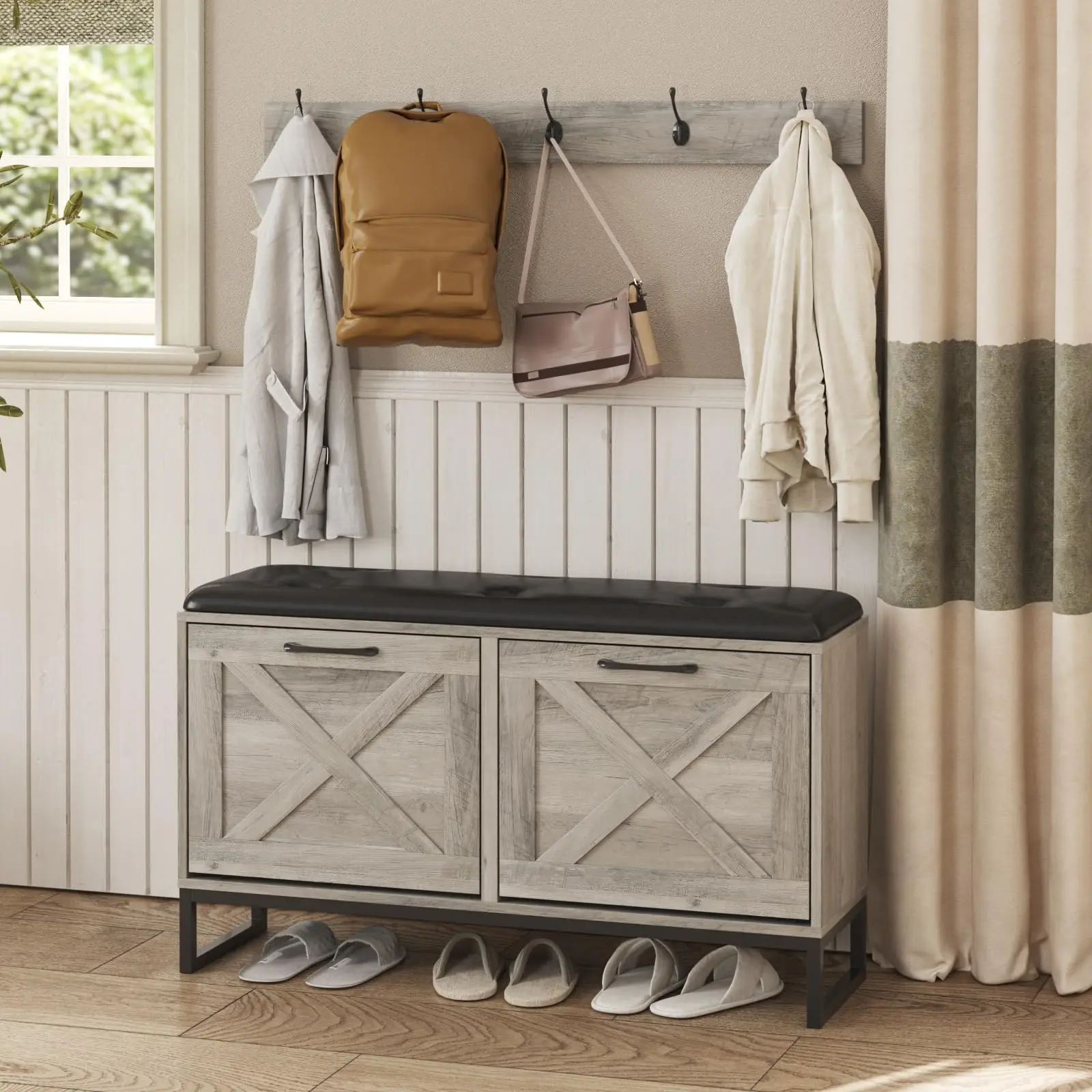
When to Prioritize Comfort vs. When to Emphasize Utility
While balance remains ideal, certain situations clearly call for emphasizing one aspect over the other. Recognizing these scenarios helps justify conscious trade-offs in your selection process.
When Comfort Should Take Priority
Comfort deserves greater emphasis when:
- Your entryway serves as a transitional sitting area where people regularly wait
- Elderly family members or those with mobility challenges use the bench frequently
- Your storage needs are minimal or well-addressed through other solutions
- The bench functions partly as decorative furniture in a formal entryway setting
In these scenarios, features like proper seat height, cushioning density, and ergonomic support become more important than maximum storage capacity.
When Utility Should Lead the Decision
Utility deserves greater emphasis when:
- Your entryway contends with substantial clutter from multiple family members
- Seasonal items require significant dedicated storage near the entrance
- Space constraints demand maximum functionality from each furniture piece
- The bench primarily serves quick transitions rather than extended sitting
In these cases, storage volume, compartment configuration, and material durability should take precedence over premium comfort features.
Balanced Approaches for Common Scenarios
Most households fall somewhere between these extremes, benefiting from thoughtful compromises:
- Young families may need substantial storage but also comfortable seating for assisting children
- Multi-generational homes require both accessibility features and organizational capacity
- Seasonal variations may shift priorities between winter (storage for bulky items) and summer (comfort for guests)
The key lies in recognizing which compromise best serves your unique situation rather than pursuing an abstract “perfect balance” that might not address your specific needs.
From Our Design Experts: Achieving Perfect Harmony Between Comfort and Function
Our design specialists at Nested Goods have developed key principles for creating entryway benches that excel in both comfort and utility without compromising either essential aspect.
The Rule of Thirds in Visual Balance
Professional designers often apply the rule of thirds to bench proportions, dedicating approximately one-third of the visual weight to comfort elements and two-thirds to structural and storage elements. This creates an immediate impression of balance while delivering practical functionality.
Material Selection Strategy
Rather than choosing materials solely for comfort or utility, select primary materials that serve structural needs while strategically incorporating secondary materials that enhance comfort:
- Hardwood frames provide structural integrity while wood grain offers visual warmth
- Metal components deliver durability while their slender profiles create visual lightness
- Performance fabrics offer both tactile comfort and practical stain resistance
Forward-Thinking Design
The most successful entryway benches anticipate evolving needs through:
- Adaptable components that adjust as family compositions change
- Classic design elements that remain relevant through shifting trends
- Modular features that can be reconfigured for different purposes
- Quality construction that supports decades of use through various life stages
Emerging Trends in Balanced Design
We’re seeing exciting innovations that further resolve the comfort-utility dilemma:
- Smart storage solutions that respond to touch for easier access
- Eco-friendly materials that combine sustainability with performance
- Customizable modular systems that adapt to changing entryway needs
- Multi-sensory design that addresses both physical comfort and psychological well-being
By applying these expert insights, you can select an entryway bench that truly delivers the perfect balance between welcoming comfort and practical utility—transforming your entryway into both a functional transition space and a warmly inviting introduction to your home.

